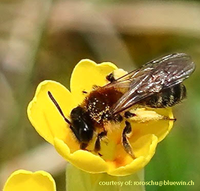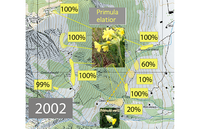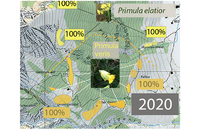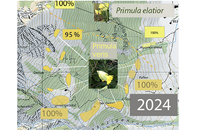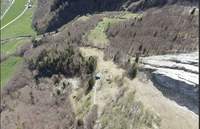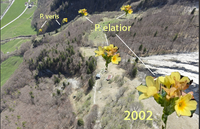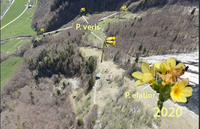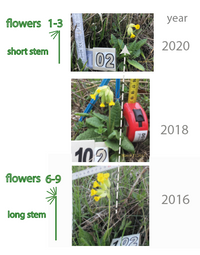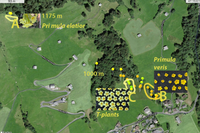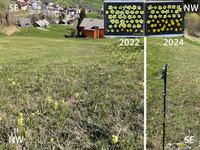SO4: Primula
(english version see below)
Es gibt neue Resultate. P. elatior --t--> P. veris ist bestätigt.
Oder Primula veris columnae --T--> Primula veris
Für eine genomische Uebersicht siehe: Whole-genome analyses disentangle reticulate evolution of primroses in a biodiversity hotspot
Beobachtungsdauer 22 Jahre. (2002-2024)
Auch im System Primula elatior/veris gibt es eine Transition.
Es ist jedoch nicht so einfach dieses System zu beobachten, weil es keinen markanten Farbunterschied der Blüten gibt zwischen den Varianten. Zudem ist die Umwandlung auf jeden Fall nur partiell (15-30%).
Die Waldschlüsselblume (Primula elatior wandelt sich dabei langsam in die Primula veris um. Dabei verändert sich die Zahl der Blüten pro Blütenstiel. In der Zwischenphase sieht der Blütenstand aus, wie derjenige von Primula v. columnae. Die Blütenstiele werden kürzer und die Blüten werden kleiner und tiefgelb. Nach der Transition blühen die Pflanzen später auf.
Die veris Formen entstehen offenbar in den Grenzzonen zwischen elatiorund /oder columnae und veris. Das ganze sieht aus wie eine Hybridisierung. Da diese Pflanzen langlebig sind und sich mit unterirdischen Stängeln (Rhizome) langsam ausbreiten, kann man diese Individuen dicht unter dem Boden metallern markieren. Mit einem Metallsuchgerät lassen sich die Pflanzen in den folgenden Jahren wieder auffinden. Das Resultat ist in jedem Fall eine Transformation der Pflanze. Das Phänomen lässt sich im Voralpenraum im Kanton Glarus und St. Gallen von 900 bis 1200 Höhenmetern an verschiedenen Orten nachweisen. Alle Populationen machen diese Transition in gleichem Sinne durch, obwohl sie nachweislich keinen physischen Kontakt miteinander haben. Der Mechanismus hat offenbar eine intrinsische Natur.
Hier ein Wollschweber an Primula elatior.
Die Blüten werden dann von Wollschwebern besucht. Bei der Primula elatior sind es ja Hummeln.
Auch Steinbienen kommen gelegentlich als Bestäuber vor, die vor allem Pollen sammeln.
Noch einmal der Hinweis, dass in der ganzen Beobachtungszeit markierte transitive Pflanzen sich nur teilweise umwandelten. Eine vollständige Umwandlung von Primula elatior in Primula veris ist daher nicht zu erwarten. - Im Uebergangsbereich können beide Formen eine Zeit lang sympatrisch in Populationen vorkommen. Ihre Blütezeit ist jedoch verschieden. Zur partiellen Umwandlung werden einige Jahre benötigt. Ohne Metall-Bodenmarkierungen, Metallsuchgerät, GPS Daten, Fotos und Einzäunung bleibt der Erfolg des Nachweises bescheiden.
Im Geisstal GL Switzerland hat sich die Zone, wo P. veris rein vorkomt in den letzten 19 Jahren um rund 200 Höhenmeter nach oben verschoben. Es sind stets reine P. elatior Population die ausserhalb des Waldes sich allmählich und partiell in P. veris umwandeln. Die Nachkommen sind dann auf jeden Fall einheitlich vom Typ veris nach Ablauf von 18 Jahren.
english version
There has been an observation period of 22 years, from 2002 to 2024. During this time, there has been a transition in the Primula elatior/veris system. However, it is difficult to observe this system as there is no significant difference in the color of the flowers between the two species. Moreover, the transition is only partial, ranging from 15-30%.
A significant change has been observed in the distribution of Primula elatior/veris individuals. The map series from 2002 revealed veris individuals up to an elevation of 1000 meters. However, in the subsequent years, veris was observed at much higher elevations (as of 2020). The latest record indicates that veris was seen at an elevation of 1350 meters in 2024. Conversely, the frequency of Primula elatior has decreased drastically to almost zero during the same period. This rate of change is too rapid to be explained by Darwinian evolution and is more likely due to an intrinsic mechanism that has resulted in the replacement of Primula elatior with veris.
see: Google map:
The forest cowslip, scientifically known as Primula elatior, undergoes a gradual transformation into Primula veris which results in a change in the number and size of flowers per flower stalk. The flowers become smaller and turn deep yellow with shorter stems, and the plants bloom later. During this process, woolly floaters visit the flowers, and in the case of Primula elatior, they are bumblebees. It is important to note that not all plants undergo a complete transformation, and some only partially transform. As a result, both forms can coexist in populations for some time in the transitional area, but their flowering times differ. A few years are needed for partial transformation, and the success of detecting this process depends on the use of metal ground markings, metal detectors, GPS data, photos, and fencing.
Vorkommen der Arten im Jahr 2002 verglichen mit der Situation im Jahr 2020. Anstieg von über 180 Höhenmeter der Artgrenze in 18 Jahren am Klausenpass.
The two species occurred in 2002 compared to the situation in 2020/21, with an increase of over 180 meters in the species limit's altitude in 18 years at the Klausenpass. In 2024, the veris individuals were seen at 1100 meters elevation. Klausenpass.
AMDEN
Plant populations in Amden.
A) The light yellow and large flowering Primula elatior.
B) The dark yellow and small flowering Primula veris.
C) In P. veris, populations interspersed by plants in transition. As a result, they show a dark yellow ring at the entrance. (April 2022)
Here's a bird's eye view of the T-plants spot. The inserts in the picture represent the proportion of different flower varieties found in the area (2024).
Due to the increased solar radiation and additional meadow drainage, the spots alter from a Primula elatior composition to a veris composition. During the last two years, this shift has even increased.
In this data space, (d*a*b) is represented,
that Primula elatior (or P. v. columnae) can change through a character shift (∆ch) into Primula veris. Plants in transition with a dark yellow-orange ring. 04-18-22 rb.
General Conclusion
It is likely that a mixed zone will transform into a stable site within the next 20 years, as it is a dynamic and unstable entity.
